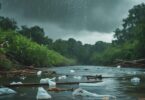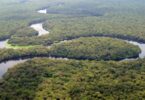It’s one of the most intense sights in nature — a towering volcano erupting in the dark, with streaks of lightning flashing through the ash-filled sky. The fiery glow, the thick black plume, and the sudden white bolt of lightning all happening at once seem almost unreal.
But this isn’t science fiction. It’s called volcanic lightning, and scientists are still studying exactly how and why it happens.
What Is Volcanic Lightning?
Volcanic lightning, also known as a dirty thunderstorm, is a natural phenomenon that occurs during some volcanic eruptions. Unlike regular thunderstorms, this lightning is created inside the volcanic plume, not from rain clouds.
It’s rare — not every volcano eruption creates lightning — but when it does, the result is dramatic, almost cinematic. It often happens during explosive eruptions when giant plumes of ash, gas, and rock particles are blasted into the atmosphere.
How Does It Happen?
The lightning is caused by electric charges building up in the volcanic plume. Here’s how the process works:
1. Ash and Rock Collision
During an eruption, the volcano shoots out ash particles, gases, and bits of rock at extremely high speeds. These materials collide with each other, creating friction — just like when you rub a balloon on your hair.
2. Charge Separation
That friction knocks electrons off some particles, giving them a negative charge, while others become positively charged. This separation of charges creates static electricity, just like what builds up in storm clouds.
3. Electric Discharge
When the difference in charge becomes strong enough, the air between the oppositely charged zones breaks down, and a bolt of lightning flashes through the ash cloud to balance the charge.
This is why lightning can appear in a plume of smoke, even when there are no rain clouds involved.
Is It Different from Thunderstorm Lightning?
Yes and no.
The physical process — charge separation and electric discharge — is similar, but the source of the friction is different. In regular thunderstorms, it’s ice and water droplets colliding. In volcanic lightning, it’s ash and rock fragments.
Also, volcanic lightning often happens closer to the ground, sometimes within just a few kilometers of the volcano’s mouth.
Why Do Scientists Study It?
Volcanic lightning isn’t just visually amazing — it helps scientists in several ways:
- Tracking ash clouds: Lightning can reveal how high and wide the plume is spreading.
- Predicting activity: A sudden burst of lightning may indicate a more explosive eruption is underway.
- Understanding eruption dynamics: By studying the electrical activity, volcanologists can learn more about the chemistry, movement, and energy of an eruption.
Researchers also want to know why some volcanoes produce lightning and others don’t. It’s still a developing area of science, but the patterns and data are useful for safety and forecasting.
Where Has It Been Observed?
Some of the most famous volcanic lightning events occurred during eruptions of:
- Mount Redoubt (Alaska) – 2009
- Eyjafjallajökull (Iceland) – 2010
- Mount Etna (Italy) – various times
- Taal Volcano (Philippines) – 2020
- Sakurajima (Japan) – frequently shows volcanic lightning
These events were captured in photos and video, often going viral because of how unreal they looked.
🧠 Did You Know?
- Volcanic lightning can happen within seconds of an eruption starting.
- Some eruptions have produced hundreds of lightning flashes per minute.
- Lightning detection networks are now used to monitor volcanic activity in real time.
Volcanic lightning shows how powerful — and interconnected — Earth’s systems are. It reminds us that energy, motion, and chemistry are always at work beneath the surface.
Understanding these processes helps us predict danger, protect communities, and appreciate the wild beauty of natural science.
So next time you see a photo of lightning striking through volcanic ash, know that it’s not just dramatic — it’s a real, powerful expression of how nature works.









